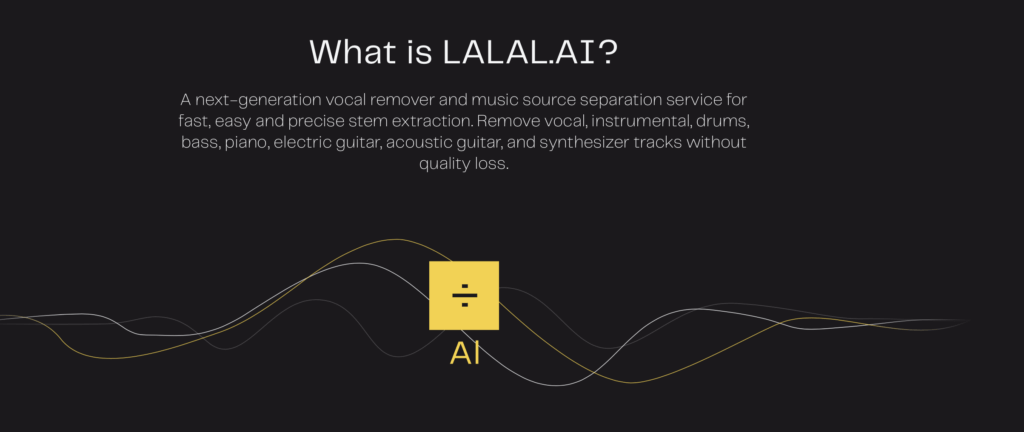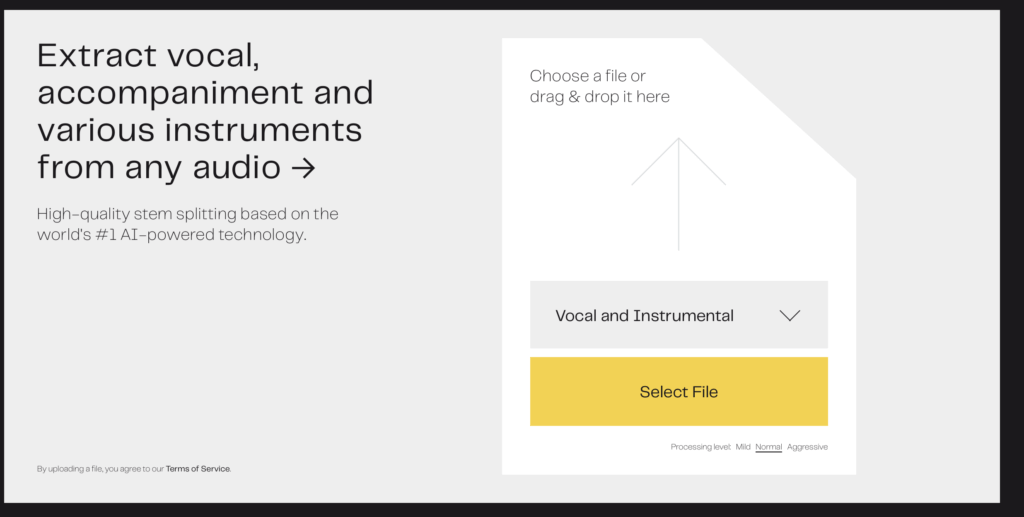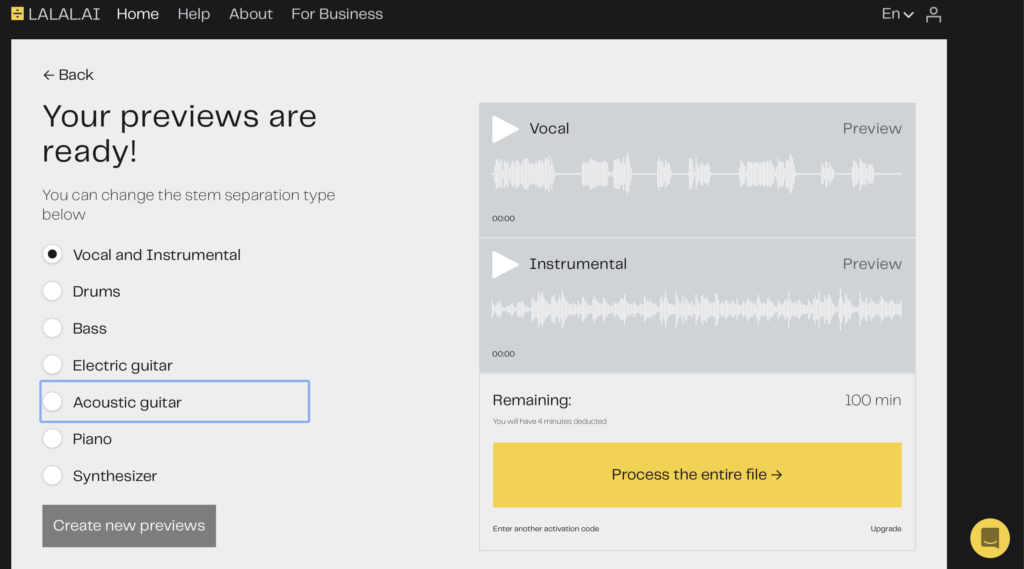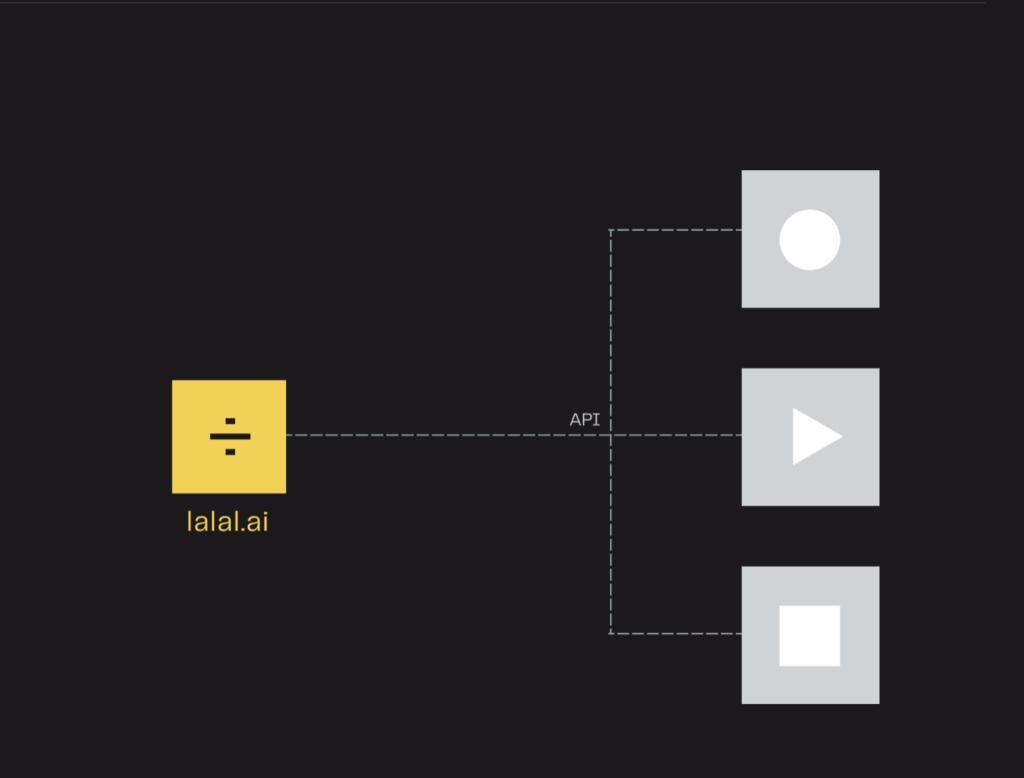We’ve seen numerous AI implementations come and go over the years, all promising amazing results, and ultimately yielding what can only be described as mild disappointments to moderate successes at best.
Which is why when we first learned of the newly unveiled vocal remover and instrumental tracks remover, lalal.ai, we approached with caution. You see, lalal.ai is an AI neural network used to extract vocal, instrumental, drums, bass, guitar (both electric and acoustic), piano and synthesizer from songs. What we’ve seen so far, though, in terms of results, have made us change our tune when it comes to how we as songwriters and recording artists can interact in meaningful ways with AI.

WHO IS IT FOR?
So, let’s start with the basics. Why would you want to remove instrumental tracks or vocals in the first place?
There are a few key examples that make sense in the world of music.
- Learning song parts – by extracting instrumental parts from a mix, you can really hear an acoustic guitar, for example, in isolation, which makes picking out chords, arpeggios and solo lines much easier than having to deal with it buried in a mix, competing with vocals, pianos, etc.
- Sampling – here’s a biggie. Let’s say you’ve come across a killer groove, vocal or horn part, but there’s just a few other things keeping the snippet that’s caught your attention from being perfectly clean and usable. With lalal.ai’s artificial intelligence technology, you can extract just the parts you want to use on your track. Maybe it’s a quick vocal hit, a percussive snap or a synth groove.
- Practicing with backing tracks – how many of us learned to solo on guitar with cheesy pre-recorded backing tapes? We’re talking pre-YouTube here, so us dinosaurs will remember the hideous cassettes that we begrudgingly used in order to improve our chops. Let’s say you’re auditioning for a new band, you can take one of their tracks, strip out vocals and other parts, and practice your solo over the rhythm section to impress them at the audition. Or you can practice your vocals over the vocal-less instrumentals if you’re aiming to be their next lead singer.
These are just a few practical examples where you’d want to remove vocals from an audio file or hear an instrumental part more clearly. We’re sure you can think of other examples that connect with your own unique situation.
HOW DOES IT WORK?
Luckily, our experience with lalal.ai was pretty easy. Once you sign up, you just drag and drop any audio filetype you can think of onto the webpage, and it’ll do its magic behind-the-scenes. Processing is surprisingly quick, and then you’re taken to a new page with all your stems in a matter of moments.

From there, you can preview any of the extracted audio and start playing the isolated parts however you see fit. The online player is intuitive (if you’ve ever played tacks on SoundCloud or similar services, you’ll be right at home), and shows you track progress through a simple-to-understand visual indicator.
Of course, once it splits the track, you can download any or all stems to play around with offline, which is where some of the above scenarios will come into play – sampling, learning parts, rehearsing and practicing your own leads, etc.
Once the AI’s work is done, it’s up to you to use the newly created stems however you see fit.
YEAH, BUT DOES IT ACTUALLY WORK?
Like we said at the top of the article, we’ve seen promises of AI platforms come and go over the years, but we think lalal.ai is truly on to something here.

One of the main selling points is that there’s no great quality loss in the separation, and for the most part that’s actually true (shock!). We processed acoustic singer/songwriter tracks as well as some more heavily arranged funk tracks and overall, we were pleasantly surprised and impressed with the ability for the AI to extract parts and separate audio with genuine clarity.
One example was a recent track from Kevin Daniel that we actually worked on as part of a bigger project with Elixir Strings. He recorded a track for us (and did some behind the scenes videos in his studio) that featured solo acoustic guitar and vocals.
The track, called “Weep and Cry,” is dynamic and features hearty strumming and heartfelt vocals. Processing using lalal.ai, we were able to remove a clean, clear vocal track and a clean, clear acoustic guitar track, perfectly separate from each other — which was quite amazing.
I know other platforms have hit the market claiming to do something similar, but usually (at least from our experiences), they tended to be full of digital artifacts, audio ghosting and other anomalies that audibly reminded you of the other parts of the songs (doesn’t that kind of defeat the purpose?). Either the AI wasn’t developed enough, or the tech has simply gotten better, but these ‘leaks’ are much less evident here. Kudos to the lalal.ai engineering team. Quality loss, at least in our experience, wasn’t an issue.

FINAL THOUGHTS
With some initial skepticism out of the way, we thoroughly enjoyed testing out the lalal.ai platform, and can see how this would be a useful tool across genres, for a multitude of reasons and use cases.
lalal.ai has informed us they are now offering a free pack for splitting 3 songs, for everyone to try and test before buying. So, if you head on over to https://www.lalal.ai you’ll see all the currently available options, and be able to demo it for yourself. Let us know what you think in the comments below.
